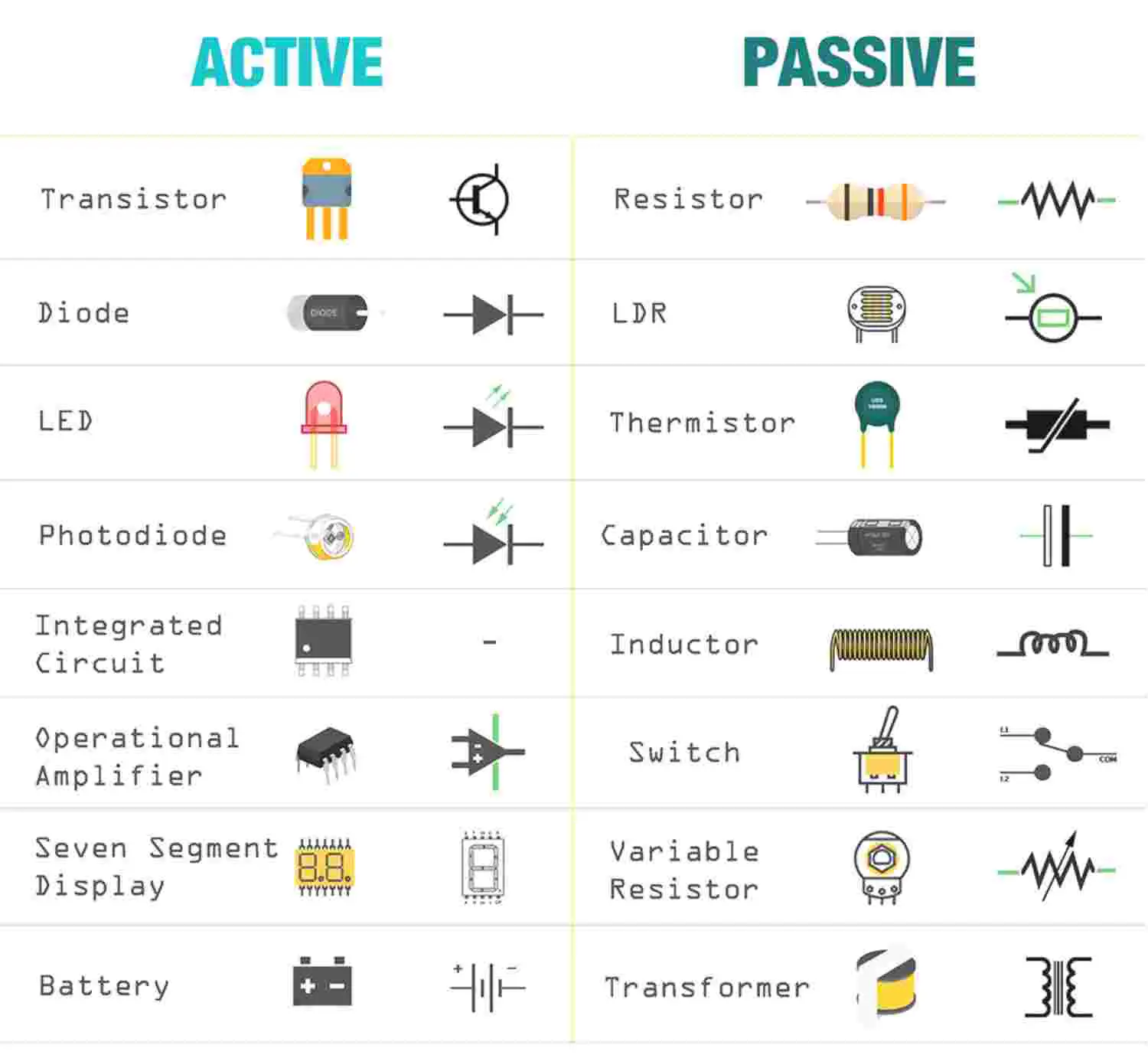Simply put, devices that require energy (power) power are called active devices, and devices that do not require energy (power) power are passive devices. Active devices are generally used for signal amplification, transformation, etc., and passive devices are used for signal transmission, or "signal amplification" through directionality. Capacitance, resistance, and sense are all passive devices, while ICs and modules are all active devices. (In layman's terms, those that require a power supply to display their characteristics are active components, such as triodes. Those that can display their characteristics without a power supply are called passive components).

Summary table of the main types of active components and the main types of passive components
1. What is an Active Component?

Active Components
An active component, in the context of electronics and electrical engineering, refers to a device or element within an electronic circuit that can control the flow of electric current. Active components have the ability to amplify, switch, or modulate signals, and they require an external source of energy to function properly. These components are capable of processing and manipulating electrical signals to perform specific functions in electronic circuits.
If an electronic component has a power source inside it when it is working, the device is called an active device.
From the perspective of circuit properties, active devices have two basic characteristics:
(1) It also consumes electric energy.
(2) In addition to the input signal, there must be an external power supply to work normally.
2. Common examples of active components include
Transistors: These are semiconductor devices that can amplify or switch electronic signals and are fundamental to modern electronics.
Operational Amplifiers (Op-Amps): Op-amps are high-gain voltage amplifiers that can perform various mathematical operations on input signals, making them essential in signal processing and analog circuit design.
Integrated Circuits (ICs): These are complex assemblies of active and passive components built into a single package. ICs can contain multiple transistors, diodes, resistors, and other components to perform specific tasks.
Diodes: While diodes are often associated with passive components due to their basic nature, some diodes, like light-emitting diodes (LEDs) and laser diodes, can also be considered active components since they emit light when current flows through them.
Thyristors and Triacs: These are semiconductor devices used for switching and controlling electrical power in various applications.
Active components are integral to the design and functionality of electronic devices, ranging from simple audio amplifiers to complex computer processors. They play a vital role in shaping and processing electrical signals, allowing engineers to create a wide range of electronic systems with various functionalities.
3. What is a Passive Component

Passive Components
Passive components are electronic elements within a circuit that do not possess the ability to amplify or control the flow of electrical current. Unlike active components, passive components do not require an external source of energy to function; they only respond to the applied electrical signals. Instead of actively processing signals, passive components primarily affect the characteristics of the signals without active manipulation.
If an electronic component works without any form of power supply inside it, the device is called a passive device. From the perspective of circuit properties, passive devices have two basic characteristics:
(1) It either consumes electrical energy by itself, or converts electrical energy into other forms of energy.
(2) Only need to input signal, it can work normally without external power supply.
4. Common Passive Electronic Components
Passive devices in electronic systems can be divided into circuit devices and connection devices according to their circuit functions.
Common examples of passive components include:
Resistors: These components resist the flow of electric current, introducing a certain level of opposition to the circuit. They are commonly used to control current flow, set voltage levels, and create voltage dividers.
Capacitors: Capacitors store and release electrical energy in the form of an electric field between two conductive plates separated by an insulating material. They are used for energy storage, filtering, timing, and coupling signals.
Inductors: Inductors store energy in the form of a magnetic field created when current flows through a coiled wire. They are often used in applications involving energy storage, filtering, and signal coupling.
Transformers: Transformers are composed of two or more coils of wire that are magnetically coupled. They are used to transfer electrical energy between different voltage levels while preserving the power.
Diodes: While some diodes are considered active components, many, like standard rectifier diodes, can be classified as passive components because they allow current to flow in only one direction.
Passive components are essential in circuit design, as they help shape and control electrical signals without actively amplifying or processing them. Engineers use passive components in various combinations to create filters, oscillators, voltage regulators, impedance matching networks, and more. The proper selection and arrangement of passive components in a circuit play a crucial role in achieving the desired functionality and performance of electronic systems.
5. Active Components vs Passive Components
Remember that both active and passive components are vital in electronic circuit design. They serve distinct purposes and work together to create functional and effective electronic systems. Below we will compare active components and passive components in an all-round way.
Comparing Active and Passive Components| Aspect | Active Components | Passive Components |
|---|
| Function | Amplify, switch, modulate signals. | Affect characteristics of signals. |
| Energy Requirement | Require an external energy source to function. | Do not require an external energy source. |
| Examples | Bipolar transistor,field effect transistor (field effective transistor),Thyristor (thyristor) also called silicon controlled rectifier, Semiconductor resistance and capacitance,operation amplifier,Comparator,Logarithmic and exponential amplifiers,multiplier/divider,analog switch,phase lock loop,voltage regulator,reference source,Waveform generator,Power amplifier,Basic logic gates,flip-flop,Register,Decoder,Data Comparator,Driver,Counter,Shaping circuit,Programmable Logic Devices,Microprocessor (mpu),SCM,DSP device.ICs | Diode,Resistor,Resistance row,Capacitor,Inductance,Transformer,Relay,Button (key),Buzzer, speaker,switch,connector,socket,Connecting cables,Printed circuit board (pcb). |
| Signal Processing | Actively manipulate signals. | Modify signals without active manipulation. |
| Current Control | Control the flow of current. | Do not control current flow actively. |
| Power Gain | Can provide power gain (amplification). | Do not provide power gain. |
| Voltage Gain | Can provide voltage gain. | Do not provide voltage gain. |
| Complexity | Can be complex, containing multiple elements. | Generally simpler in construction. |
| Energy Conversion | Can convert energy (e.g., transistor switching). | Do not convert energy in the same way. |
| Examples in Circuits | Used in signal amplification, signal processing, control. | Used in filtering, impedance matching. |
| Response to Signals | Respond to input signals and modify them. | Respond to signals by affecting them. |
| Primary Functionality | Active signal processing and control. | Signal conditioning and shaping. |
| Active Participation | Actively influence circuit behavior. | Passively affect circuit characteristics. |
| Role in System Design | Crucial for designing complex functions. | Essential for signal conditioning and control. |
| Energy Dependency | Dependent on an external power source. | Independent of an external power source. |
6. Summary
Active components are the core of electronic circuits, and all oscillation, amplification, modulation, demodulation, and current conversion are inseparable from active components.
A device that can independently exhibit its external characteristics without relying on the existence of an external power source (DC or AC) is a passive device. Beyond that are active devices.
The so-called "external characteristics" is to describe a certain relational quantity of the device, although voltage or current, electric field or magnetic field pressure or velocity are used to describe the relationship.
The external characteristics of passive components have nothing to do with whether they exist as driving sources. The concepts of passive and active not only exist in electrical components, but also in the fields of machinery, fluid, heat, and acoustics.

Nantian Electronics a professional distributor of electronic components, providing a wide range of electronic products, saving you a lot of time, effort and cost through our meticulous order preparation and fast delivery service.
Share this post


